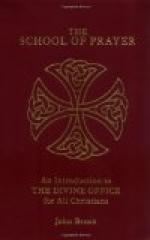March. St. Joseph. In the Western Church the cultus of St. Joseph is not found in any calendar before the ninth century, although numerous traces of the esteem and veneration paid to him by individuals are found. The public cultus of St. Joseph was introduced by the private devotions of great servants of God, such as St. Bernard, St. Gertrude, St. Bridget of Sweden, John Gerson, St. Bernardine of Sienna, and other Franciscan preachers. The spread of the devotion in several countries led Pope Sixtus IV. (1471-1484) to introduce St. Joseph’s feast, as a simplex, having only one lesson. Clement XI. (1700-1721) changed it into a feast of nine lessons. Two centuries previously the feast is found in Breviaries under date 19th March.
The Annunciation. Devotion to the Mother of God was continued by the apostles after the death of her Son. Fervent and widespread devotion is traceable in the Church’s early days, but the organising of our Lady’s feasts was a work of some time and difficulty. A great difficulty was the fear of blasphemy from pagans, and of error amongst pagan converts, so trained in myths and genealogies of the gods. Then the festivals commemorating the facts of the life, death and resurrection were primarily commemorative of the Redeemer and secondarily of His Mother. Long before the institution of her feast, the cultus of Mary was almost universal. The feast of the Annunciation falls on the 25th March with us. Its date depends entirely on the date of Christmas, but the birth of Christ was not always placed in calendars on the 25th December.
In early days the feasts of martyrs and other saints were not celebrated in Lent, and hence this feast of the Blessed Virgin was set down in some calendars as transferred, and was celebrated in Advent. In Spain, it was celebrated eight days before Christmas. In the East, the feast was generally celebrated on the 25th March, and gradually this date was fixed, and was sanctioned by several councils in the eleventh century.
May. The Finding of the Holy Cross. The history of the finding of the true cross by St. Helena is well known. The Alexandrine Chronicle gives the day as the 14th September, 320. This September feast of the holy cross is of earlier origin than the feast of May. The latter was established to commemorate the act of the emperor in 629, when he brought back to Jerusalem the true cross, from the Persian conquerors. On 3rd May, he handed it over to the Patriarch Zacharias, and, strange to say, this festival of May spread rapidly in the Western Church, whilst in the East only one feast, (the September one), of the finding of the cross was celebrated for centuries. In Milan, for instance, the September feast was received in the eleventh century, whilst the May feast was rooted in the Western Church very many years before that time.
The antiphons and hymns of this Office are, it is said, amongst the most beautiful and sublime prayers of our liturgy.




